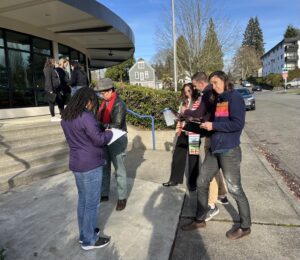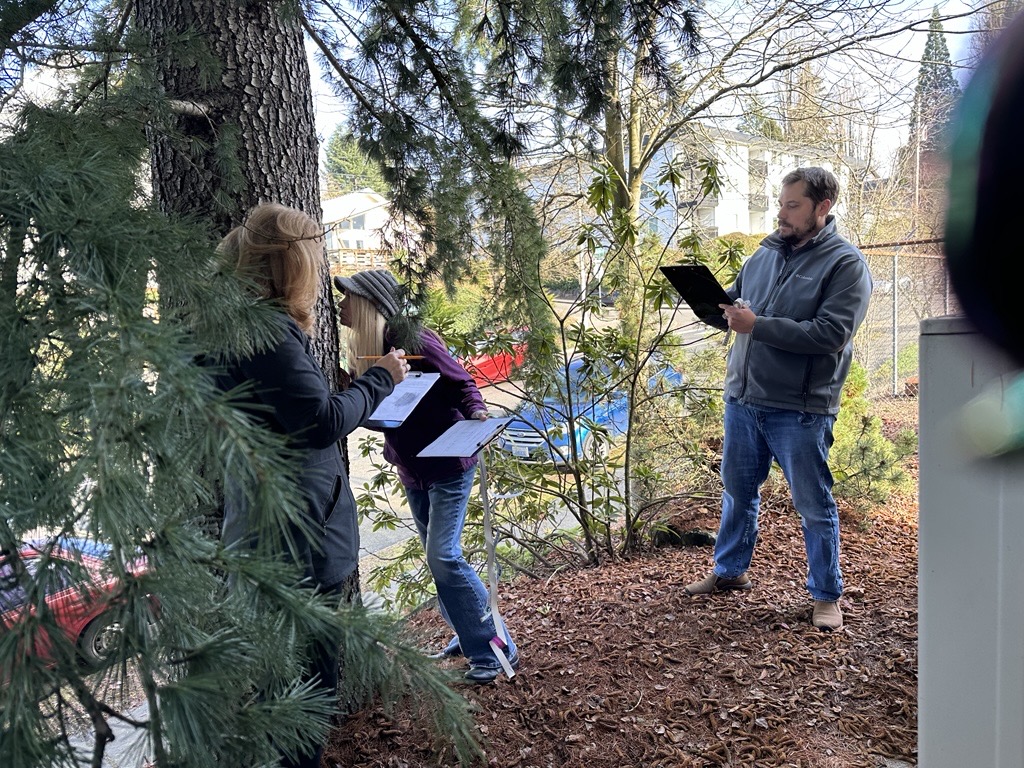Employees at Olympia School District’s central office would have seen an unusual sight if they looked out their windows on December 11th: a group of middle school teachers repeatedly walking around the building, looking up and down, as they attempted to determine how stormwater flowed from the roof to the ground.
“Their job was to map how water flowed at their school, but they were at the district office, which isn’t as familiar,” says PEI’s South Sound FieldSTEM Coordinator Lauren Troyer. “As they were walking around the building trying to figure out where the water that lands on the roof goes, they couldn’t find any downspouts. They really got engaged in the problem, just like students would.”
The activity was part of a customized professional learning session during an OSD in-service day. Troyer is a former OSD middle school science teacher, so the attendees were her previous colleagues. She designed customized activities for each grade level based on the content teachers cover.
“My goal was for them to take the science they’re already doing and build their confidence to take kids outside,” Troyer explains. “I wanted to give them really doable PEI resources for each grade level that align with their curriculum.”
For 6th-grade teachers, that meant tools and activities related to stormwater. In 7th-grade, the topic is renewable energy and Troyer shared PEI’s renewable energy Solutions Oriented Learning Storyline

(SOLS). 8th-grade teachers focused on how trees build mass and store carbon. Teachers were intrigued by a carbon storage tape from Port Blakely that measures how much carbon a tree stores based on its diameter.
“I really found the resources for including the Southern Resident Orca Whales into my 6th-grade curriculum to be particularly valuable. The resources help me add layers to the student understanding and what they learn from other community partners. I also really appreciate the fact that since Lauren was just in the classroom, she has a great idea of what students need and what is realistic for teachers.”
— Courtney Jarmon,6th-grade science teacher, Washington Middle School
“For example, if a tree has a two-inch diameter, it’s storing the equivalent of 50 miles of a school bus driving,” says Troyer. “That’s not a large tree, but it stores so much carbon. The teachers get so excited about these carbon tapes. It helps to have this tangible way to explain carbon sequestration.”
Teachers at all grade levels learned about the plight of J-50, an endangered southern resident orca, and the Lummi Tribe’s efforts to keep her alive. The story, part of the Explore the Salish Sea curriculum, makes all three topics – stormwater, renewable energy and forest carbon sequestration – instantly relevant for students. “They’re presented with this phenomenon, and they start wondering why this little orca is dying,” says Troyer. “It grounds them in why these issues matter; why stormwater should be clean before it gets into the sea. It creates a heart connection for the whole unit.”
“I really found the resources for including the Southern Resident Orca Whales into my 6th-grade curriculum to be particularly valuable,” says Courtney Jarmon, a 6th-grade science teacher at Washington Middle School. “The resources help me add layers to the student understanding and what they learn from other community partners. I also really appreciate the fact that since Lauren was just in the classroom, she has a great idea of what students need and what is realistic for teachers.”
Troyer also shared information about the Squaxin Island Tribe and the history of treaties and fish wars in the Puget Sound region. “These educators are teaching in the ancestral home of the Squaxin Island Tribe,” she notes. “I wanted them to know that the Squaxin Island Tribe and other Coast Salish tribes are co-managers of fish and have treaty reserved rights, so they’re very much involved in the whole story today.”
After each grade level cohort conducted their field investigation, the group reconvened to explore PEI’s resources. Each teacher received a customized folder of relevant materials for their grade level.
“This was a great way for me to familiarize them with PEI resources,” says Troyer. “Their response was positive and they were reflecting on how they might apply what they learned.” She will meet with the group for a virtual check-in during their collaboration time in February and conduct another field investigation workshop at their spring in-service day.
